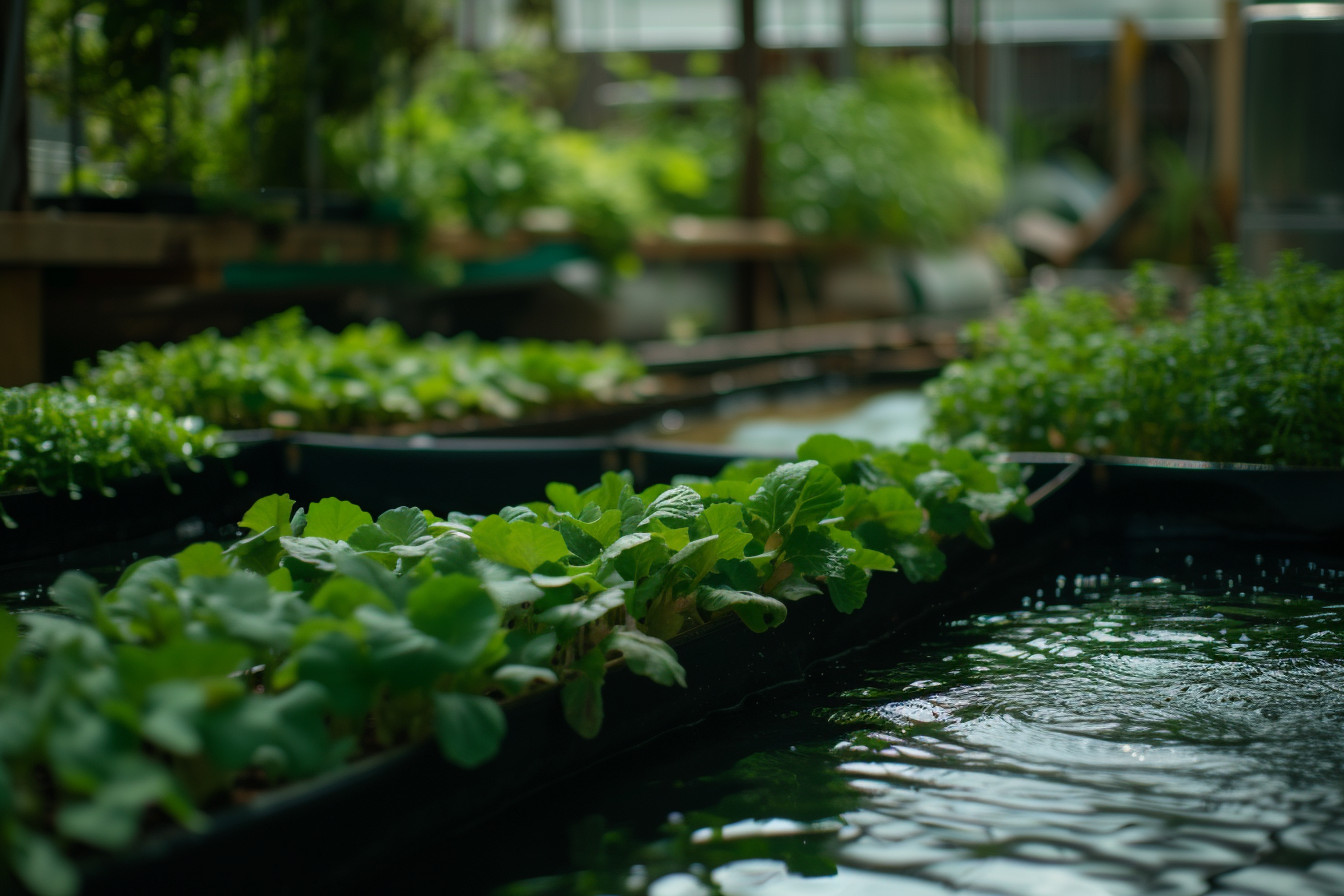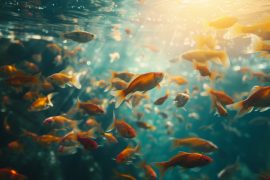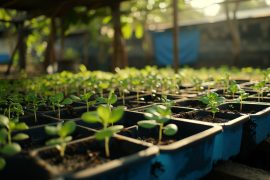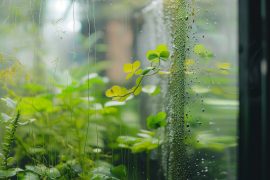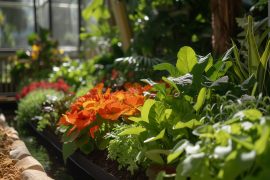Delving into the world of aquaponics can feel a bit like stepping into nature’s own laboratory, where life thrives in a delicate balance. For us gardening enthusiasts leaning towards sustainability and self-sufficiency, it’s an intriguing space to explore. The chemistry behind nutrient cycling within these systems is not just fascinating; it’s foundational to understanding how our aquatic gardens flourish.
At its core, the magic of an aquaponic system lies in its ability to recycle nutrients from fish waste into food for plants, which then purify water that returns back to the fish tanks. Think of it as Mother Nature’s circle-of-life moment on hyperdrive! What excites us as gardeners is not only getting closer and deeper with our green friends but also unlocking this sustainable process right at home or in community spaces around us.
Getting down-to-earth—or should we say “down-to-water”—the transformation happens through some pretty amazing biochemistry involving nitrifying bacteria converting ammonia (bad news for both humans and fish) from waste directly ‘into nitrites first’, before transforming them ‘into nitrates’.
These are golden tickets because they’re plant-ready nutrients aimlessly swimming until roots catch hold—completing one heck of an eco-friendly cycle. And guess what? We get fresh greens and happy swimmers out of this deal without adding synthetic fertilizers or performing frequent disruptive cleanings common in traditional farming methods!
Understanding Nutrient Cycling
Diving into the world of aquaponics, we’re met with a symphony of elements working in harmony, much like an orchestra tuning before a grand performance. At its heart lies nutrient cycling, a process as vital to our aquatic garden as water is to fish. Let’s break it down.
Picture this: Your aquaponic system isn’t just any garden; it’s where two worlds collide and thrive together—fish swimming contentedly below while plants soak up sunlight above. But how do these seemingly different lives support each other? Enter nutrient cycling—a nature-inspired recycling program that could give even the most efficient municipal systems a run for their money.
Fish produce waste—we can’t shy away from that fact—but what might seem troublesome at first glance actually kickstarts our journey towards sustainability. This waste contains ammonia, which, although toxic if accumulated, becomes plant gold through nitrification thanks to some microscopic allies—beneficial bacteria—converting ammonia into nitrites and then nitrates utilized by eager green leaves on top.
To visualize, let’s lay out some numbers:
| Step | Description |
|---|---|
| Ammonia | Fish release ammonia directly through excretion. |
| Nitrite | Beneficial bacteria convert ammonia into less harmful nitrite. |
| Nitrate | Another set turns those nitrites into pure gold—food for plants! |
But why does this matter? In traditional farming or gardening setups, soil replenishes itself seasonally, naturally handling waste but also sometimes chemically with added fertilizers, introducing potential imbalances or pollution risks not present here.
The Role of Chemistry in Nutrient Cycling
When we dive into the world of aquaponics, it’s clear that chemistry isn’t just a subject you snoozed through in high school; it’s at the heart of making these ecosystems thrive. Aquaponic systems are fascinating blends where fish and plants live together symbiotically, but for them to flourish, understanding nutrient cycling is crucial.
So here’s how nature does its magic: Fish produce waste (yep, we’re talking about poop), which might seem like an end product but actually kicks off this incredible cycle. This waste breaks down naturally with help from our microscopic buddies, bacteria. These tiny creatures convert ammonia (toxic to fish if levels get too high) into nitrites and then nitrates—substances your leafy greens can’t get enough of!
But hold up! It doesn’t stop there.
- Fish waste becomes food for beneficial bacteria.
- Those bacteria transform waste into plant-ready nutrients.
- Plants absorb those nutrients they need big time while cleaning water as part of their deal.
Isn’t that neat? And yeah, don’t forget that Ned gets his home freshly cleaned by the plants he lives with. Talk about teamwork, right?
Now take lettuce grown traditionally in soil-based farming versus floating placidly atop an aquaponics system, which takes nearly the same amount of input but produces more harvests year-round owing to closet-controlled conditions. I could go on about pros and cons until cows come home. The point being, when it comes to sustainability yield, a hard beat approach
What sticks out here aren’t going-gush numbers, though seeing tangible results firsthand is uncanny. The table below gives a quick glance at what to expect in terms of growth comparisons of lettuces using the former and latter methodologies, respectively. Just a glimpse of the power of clever chemical reactions driving the whole operation forward Let beauty lie in simplicity and complexity combined.
| Soil-Based Farming | Aquaponic Systems | |
|---|---|---|
| Growth Rate and Yield: ”`’ Essentially faster double output, half space, less predictable dependent seasonal changes, external factors |
Essential Nutrients for Plants in Aquaponic Systems
Diving right into the heart of aquaponics, we’re met with a fascinating intersection between aquatic life and plant growth. It’s here that fish and plants form an unlikely alliance, thriving together within this cycle of nurture. For folks who’ve found themselves enchanted by the delicate balance of nature’s systems, understanding what makes these green beauties tick is nothing short of magical.
Nitrogen kicks things off as our first star player on the list. Now you might be thinking—nitrogen? Yep! In any garden paradise (aquaponic or not), it reigns supreme for its role in leaf development and vibrant green hues that make your space pop with color. But how do plants get their hands—or roots—on nitrogen in such a setup? Cue those finned friends swimming about—they play a pivotal role through their waste products, which undergo conversion to nitrate—form orchards can easily assimilate thanks to beneficial bacteria calling your system home.
Following closely behind are phosphorus and potassium, giving us quite the dynamic trio when married with nitrogen.
- Phosphorous steps up big time, aiding root development and ensuring they’re sturdy enough to support all above-ground activities from flower bloom size chart champions.
- Meanwhile, potassium wears many hats, affecting almost everything related to well-being, like water uptake, disease resistance, and even flavoring some types of fruit and veggies!
To imagine an aquaponics setup lacking micronutrients like calcium, magnesium, and iron would, speaking frankly, be a gardening faux pas of the highest order!
| Micronutrient | Role |
|---|---|
| Calcium | Cell wall integrity, flowering prowess, fertility, cheerleader |
| Magnesium | Chlorophyll production, photosynthesis, and MVP |
| Iron | Enzyme activation chiefly aids chlorophyll formation in critical stages. |
The Nitrogen Cycle in Aquaponics
Diving into the world of aquaponics, we’re met with a fascinating process at its core: the nitrogen cycle. This isn’t just any old natural occurrence; it’s what turns an aquaponic system from a collection of tanks and plants into a self-sustaining ecosystem. To understand why this is so crucial, let’s break down how it all works.
At heart, fish waste might not sound like something to get excited about, but bear with us—it’s gold for plant growth! Here’s the lowdown: Fish produce ammonia as waste. While too much can harm aquatic life if left unchecked, here comes nitrifying bacteria to save the day—quite literally transforming this potential toxin into useful forms of nitrogen that our leafy friends thrive on.
- First, beneficial bacteria called nitrosomonas jump onto the scene, converting ammonia (NH3) to nitrite (NO2).
- Then another group enters—nitrobacter takes these nitrites, turning them further into nitrates (NO3), which now become highly accessible food for plants.
These transformations create an incredible collaboration between water dwellers and green tenants sharing their living space—the essence behind effective nutrient cycling and arguably one reason folks are amazed by aquaponic setups!
But wait, there’s more texture to add! Let me sprinkle some statistics, because who doesn’t love numbers showing off success stories? Studies document significant improvements in plant growth rates when embraced within such systems—a testament indeed.
| Plant Type | Growth Improvement Rate (%) |
|---|---|
| Leafy Greens | Upwards of 50% |
| Tomatoes | About 25% |
| Herbs | Ranging from 30%–40% |
While figures give clues towards effectiveness, they also highlight engagement possibilities across community centers and schools—anywhere, really, where educating on sustainable practices stirs interest.
The Importance of pH in Nutrient Cycling
Diving into the crux of aquaponic systems, we often marvel at how fish and plants can symbiotically coexist to support each other’s life cycles. But have you ever stopped to ponder what magic ingredient makes this system tick so effectively? Well, folks, it turns out that one pivotal factor is something as seemingly mundane yet profoundly critical as pH level!
pH levels essentially act like a master key to unlocking nutrients within these closed-loop ecosystems. For our green friends (the plants), absorbing vital nutrients (nitrogen, phosphorus, and potassium) hinges on maintaining an optimal pH window ranging roughly between 5.5 and 7.0.
Now why does this matter so much? In simple terms:
- With too low a pH (too acidic), certain essential minerals become overly abundant to toxic levels, while others stay locked away.
- On the flip side, with high alkalinity or basic conditions, elements such as iron begin playing hard-to-get, leaving some needed resources inaccessible for plant uptake.
Maintaining Water Quality in Aquaponic Systems
Keeping the water quality top-notch in aquaponic systems is like hitting a moving target—it’s all about balance and timing. Just like plants need sunlight to thrive, fish and bacteria require certain conditions for a healthy habitat that supports your whole system.
Understanding pH levels plays a crucial role here. It’s not just some numbers game; think of it more as creating the perfect homey environment for both your close friends and green buddies alike. Plants generally prefer slightly acidic environments (pH 5-7), while most fish demand neutral to mildly alkaline waters (pH 6–8). However, aligning stars isn’t necessary—aiming for that sweet spot around pH 6–7 usually keeps everyone happy.
Let’s talk about the nitrogen cycle, because honestly, this is what makes or breaks an aquaponics setup! Ammonia from fish waste gets transformed into nitrites by one set of beneficial bacteria, then further converted into nitrates by another friendly bacterium brigade, which finally become plant food. Here are some quick stats:
| Stage | Converter |
|---|---|
| Fish Waste | Ammonia |
| First Transformation | Nitrite-producing Bacteria |
| Second Transformation | Nitrate-producing Bacteria |
Maintaining oxygenation can’t be overstated either—aerating your tank ensures dissolved oxygen stays at levels high enough to support aquatic life but also fosters bacterial health, ensuring those transformations happen without hitch.
Filtering out solids sounds mundane, yet it prevents buildup affecting pump mechanisms down line, whereas frequent testing brings peace of mind, letting you adjust course swiftly if things start looking sideways!
In sum, diving deep into the ins and outs, maintaining stellar water quality rewards with lush leaf growth and vibrant swimming colors, and setting the stage for peaceful, harmonious interaction among these diverse inhabitants of our little ecosystems.
Challenges and Solutions in Nutrient Cycling
Navigating the delicate balance of nutrient cycling in aquaponic systems presents a unique set of challenges. Yet, for every challenge we face, there’s an innovative solution waiting to be discovered (or sometimes rediscovered). It’s like solving a complex puzzle where each piece must perfectly fit.
One common hurdle is ensuring that plants receive all necessary nutrients purely from fish waste—a feat easier said than done. Fish feed lacks certain microelements essential for plant growth, such as iron, calcium, and magnesium. To tackle this issue head-on, many gardeners have turned to supplementing these missing elements directly into the water. For instance:
- Iron can be added using chelated iron supplements.
- Calcium levels get a boost from adding hydrated lime.
- Magnesium needs are met by incorporating Epsom salts.
A meticulous approach allows us to ensure our green friends don’t miss out on anything they need while keeping everything organic!
Water quality parameters also play a crucial role, but managing them isn’t always smooth sailing, especially with fluctuating pH levels, which could throw off nutrient absorption rates or harm aquatic life if not monitored closely enough!
Here’s what savvy growers do—the old trial-and-error method paired with digital meters makes it much simpler; regular checks keep things within safe bounds, thus maintaining harmony between fishy inhabitants and leafy dwellers alike under one roof, Aquaponics style!
Ultimately, figuring out the principles of sustainability, technology, and achieving a thriving ecosystem encapsulates the very essence of why we love engaging in these kinds of projects. They’re small worlds that model how humans live symbiotically on planets, reinforcing connections. Mother Nature’s calm rhythm found working alongside her proves therapeutic, educational, and thrilling season after season.
Final Thought
Wrapping our heads around the chemistry of nutrient cycling in aquaponic systems feels a bit like we’ve been on an epic journey, doesn’t it? We’ve waded through the waters (quite literally) to uncover how this incredible system can mimic what happens naturally in our world’s most vibrant ecosystems. Let’s pull up a chair for one last chat about why all these pieces matter and where they leave us standing (or sitting!) with respect to sustainable gardening practices.
Firstly, remember that heartwarming feeling you get when everything just clicks together perfectly? That’s pretty much how aquaponics works—with fish and plants joining forces in perfect harmony. The synergy found within these closed-loop systems isn’t only fascinating; it’s downright revolutionary! Who would’ve thought those waste byproducts from your swimming buddies could turn into green-thumb gold?
Now let’s boil things down: at its core, understanding the chemistry allows anyone willing to roll up their sleeves—figuratively or not—to maintain balance within their own ecosystem.
- Nitrogen cycles keep plants thriving without traditional soil.
- pH levels, which play Goldilocks until conditions are “just right.”.
- Essential nutrients circle back continuously, so nothing goes to waste.
It sounds simple enough, but believe us, tuning into nature requires patience and practice. It teaches an important lesson, though: conservation is key as we seek out more Earth-friendly ways of producing food sustainably.
Real talk time: diving deep into such topics might scare off some folks initially because, hey, science seems intimidating…until you realize it plays a part every day outside academic walls too!
